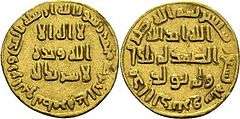Mithqal
Mithqāl (Arabic: مثقال) is a unit of mass equal to 4.25 grams which is mostly used for measuring precious metals, such as gold, and other commodities, like saffron.

The name was also applied as an alternative term for the gold dinar, a coin that was used throughout much of the Islamic world from the 8th century onward and survived in parts of Africa until the 19th century.[1] The name of Mozambique's currency since 1980, the metical, is derived from mithqāl.[2]
Etymology
The word mithqāl (Arabic: مثقال; “weight, unit of weight”) comes from the Arabic thaqala (ثقل), meaning “to weigh”. Other variants of the unit in English include miskal (from Persian or Urdu مثقال; misqāl), mithkal, mitkal and mitqal.
Indian mithqaal
In India, the measurement is known as mithqaal. It contains 4 mashas and 3½ raties (rata'ii; مثقال).[3]
It is equivalent to 4.25 grams when measuring gold,[4] or 4.5 grams when measuring commodities.[5] It may be more or less than this.[6]
Conversion factors
| Unit | Mithqāl | Gold dinar | Dirham | Gram | Troy ounce | Ounce | Grain |
|---|---|---|---|---|---|---|---|
| Mithqāl | 1 | 1 | 0.70 | 4.25 | 0.13664 | 0.14991 | 65.5875 |
The mithqāl in another more modern calculation is as follows:
| Unit | Mithqāl | Nākhud | Gram | Ounce |
|---|---|---|---|---|
| Mithqāl | 1 | 19 | 3.642 | 0.117 |
Nakhud is a Bahá'í unit of mass used by Bahá'u'lláh.[7] The mithqāl had originally consisted of 24 nakhuds, but in the Bayán, the collective works of the Báb, this was reduced to 19.[8]
See also
- Troy ounce
- Gram
- Gold gram
- Nisab
- Mithqal Al Fayez
References
- Johnson, Marion (1968), "The Nineteenth-Century Gold 'Mithqal' in West and North Africa", The Journal of African History, Cambridge University Press, 9 (4): 547–569, doi:10.1017/s0021853700009038, ISSN 0021-8537, JSTOR 180144
- "Metical" in Dicionário da Língua Portuguesa com Acordo Ortográfico. Porto: Porto Editora, 2003-2015. Accessed 1 April 2015. (in Portuguese)
- Quarterly Journal of the Pakistan Historical Society. Pakistan Historical Society. 1 January 2006. p. 86.
- "Assessing the Nisaab of bank notes". IslamWeb. 2007. Retrieved 9 March 2007.
- "M". Economic Glossary. Archived from the original on 28 September 2007. Retrieved 9 March 2007.
- "Glossary". The Clear Path. 2005. Archived from the original on 28 September 2007. Retrieved 9 March 2007.
- Smith, Peter (1 January 2000). A Concise Encyclopedia of the Baháí Faith. Oneworld. p. 250. ISBN 9781851681846.
- Honeyman, Nobel Augusto Perdu (5 May 2004). La relevancia de la pragmática en la traducción de textos multi-culturales: versión del Kitab-i-Aqdas (in Spanish). Universidad Almería. p. 508. ISBN 9788482406473.
| Look up mithqal in Wiktionary, the free dictionary. |